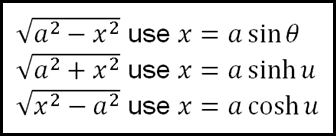WARNING: You need to fully master integration and differentiation before you continue on this section.
SUMMARY OF PREVIOUS SECTION
Before I start, let me just give you some results of combining all of the derivatives and integrals of trigonometric, inverse trigonometric, hyperbolic and inverse hyperbolic. This will give you a clearer picture of what you have learnt for the past 2 sections:
1. The Integrals of the Inverse Polynomials
Here I reorganize the tables of integrals for your reference:
As you can see, there is a pattern that you can easily memorize. It’s either of the form a2–x2, x2–a2 or a2+x2, whether with the square root or not. You also see that they are all quadratic expressions, in which you could use the method of completing the squares to solve similar cases. For example,
Also, make sure that the coefficient of x is always 1. Another example,
Notice that if you didn’t, you would have got a different answer.
2. Trigonometric & Hyperbolic Substitution
Examples of integration like
can’t be solved by normal ways. You might have learnt one trigonometric substitution to solve this kind of questions in Maths T. But now that you have learnt hyperbolic functions, your vocabulary of substitutions increases to 3 of them. Whenever you face the integrals of this kind, you will:
3. Some extra tips on integration
These are just some short notes that I jotted down while I was studying for this chapter few years ago. I thought I might wanna share with you all:
a.
This kind of integration makes use of the half angle formula. This applies to hyperbolics as well.
b.
From here, you do integration by parts, with t2 as u and the term in the bracket as v.
c.
Notice that it must be e2x. Here you use the substitution ex = sinh x. Similarly, if the term in the square root was e2x – 1 or e2x + 1, you substitute ex as cosh x or sin x respectively. Try and see whether it works.
d. 
You might want to try proving this before you use it. This will be useful for the next section.
e. 
I actually learnt this in University. You should remember this by memory, it might come useful.
Alright, let’s get into the topic:
REDUCTION FORMULAE
A reduction formula is an expression of a definite integral in terms of n, relating the integral to a similar form of itself. For example,
Notice that firstly, it is a definite integral, which means that it has upper and lower limits. Then, it relates to itself, with a decrease of power or so. These formulae can be very helpful, especially when you calculate high powers of these functions. So if you want to find
You can use the reduction formula to get
which is easily solvable.
Solving is easy, but the harder part is the proof. It can be very very complicated and tedious if you are doing this for the first time. It is not easy to straight away identify how to integrate (as in who is the ‘u’ and who is the ‘v’ if you’re using integration by parts), and sometimes, you take hours to solve just a simple question. I’ll show you the proof for the above example so you’ll know what I mean. Using my famous colour coded integration by parts formula,
handing over the sinn x term from the right to the left, we get
Complicated? Unfortunately, most exam questions on Reduction Formulae are all on proving them. Since you need A LOT of exercises (seriously, I bold it because this is no joke), I’ll give you some examples for you to prove.
Not hard enough? Try 2 variables then:
Hope you haven’t start to freak out yet. I seriously haven’t tried proving all these Reduction Formulae, so if you have done so, I salute you. I can give you some tips here though:
1. Break down cosn x = cos x cosn-1 x and tann x = tan2 x tann-2 x.
2. Try checking out the expressions on the right. When there’s a n – 1, you know that the term with the power of n needs to be differentiated once, and n – 2, will be differentiate twice. m + 1 means that term will be integrated.
3. For those which are related to polynomials and roots, you will find the formula d. above very useful.
I remember I spent a whole night doing one Reduction Formula, because my teacher hasn’t taught me Integration yet. So take heed of my advice, and practise. ☺





I think there's an error with the last part of the reduction formula with 2 variables. It should be I {m,n}= (n-1)I{m,n-2}/m+1. Btw it's a wonderful blog =)
ReplyDeleteThere is no error. Check your calculations again.
ReplyDeleteExcellent and very helpful! Thank you!
ReplyDelete